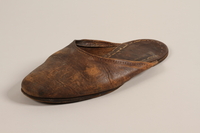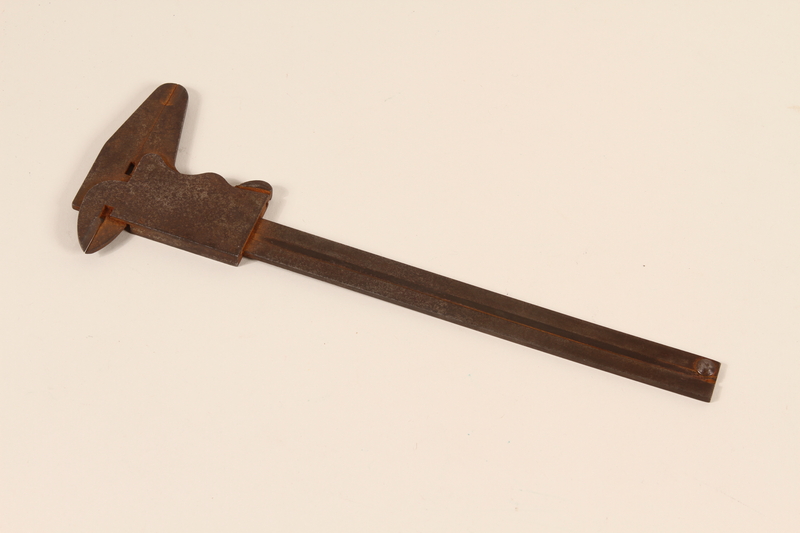Overview
- Brief Narrative
- Vernier calipers, a measuring tool, used by Sam Klasner in Oskar Schindler's armament factory in Brünnlitz (Brnenec), in German occupied Czechoslovakia from October 1944-May 1945. The factory was a subcamp of Gross Rosen concentration camp. Schindler protected his workers from deportation, kept German camp personnel out of the camp, and did his best to provide food, although shortages were severe. In October 1944, when Schindler moved his factory from Płaszów to Brunnlitz, his workers were processed at Gross Rosen. Some were mistakenly sent to Auschwitz and had to be replaced. Sam had mechanical skills and was offered a spot on Schindler's list and sent to Brunnlitz. Sam was first imprisoned by the Germans in 1939 as a Polish soldier captured after the German invasion of Poland. When they realized he was Jewish, he was incarcerated in the Krakow ghetto. In June 1941, he was sent to Reichshof [Rzeszow] forced labor camp. In September 1942, he was transferred to the brutal Płaszów labor camp until his transfer to Gross Rosen in 1944. Schindler left the Brunnlitz camp on May 7, 1945, the day Germany surrendered. The camp was liberated May 9 by Soviet troops. Sam was sent to Poland to search for his family but found no survivors. He was nearly killed in a pogrom and left for the American zone of occupation in Germany. He learned that his family had been killed in Treblinka and Auschwitz. Sam stayed in Regensburg displaced persons camp and emigrated to the United States in 1949.
- Date
-
use:
1944 October-1945 May
- Geography
-
use:
Brünnlitz (Concentration camp);
Brněnec (Czech Republic)
- Credit Line
- United States Holocaust Memorial Museum Collection, Gift of Bruce Klasner
- Contributor
-
Subject:
Sam Klasner
- Biography
-
Samuel Klasner was born on September 8, 1917, in Wolbrom, Poland, to Bella and Jozef Klasner. He had two sisters, Lola, born in 1905, and Rachel, and three brothers, Wolf, the eldest, born on June 12, 1896, Adolf, and Bernard, born in 1910. Jozef was killed during an anti-Jewish pogrom in 1926. Sam was a member of a Zionist youth organization. His sister Lola Gilbert and her husband left for Rio de Janeiro in 1932.
In late summer 1939, Sam was drafted into the Polish Army. On September 1, 1939, Nazi Germany invaded Poland which soon surrendered to the Germans. Sam was sent to a prisoner of war camp. When his captors discovered that he was Jewish, he was sent to the Jewish ghetto in Krakow. On June 2, 1941, Sam was sent to Reichshof (Rzeszow) forced labor camp. In September 1942, he was transferred to Płaszów forced labor camp near Krakow where he worked in a textile factory. Płaszów was a brutal camp, where the arbitrary beating and murder of prisoners by the guards was a daily activity. Sam was a tailor and he sewed false bottoms in his tool pouch in which he hid potato peelings that he got from the kitchen. He became friendly with an SS officer who would give Sam food in exchange for items Sam knitted for the man's wife. On one occasion, Sam was caught taking potato peels by another SS guard, and the other guard intervened. Even though it was February, the guard took him outside, doused him with cold water, and left Sam to die. Sam next was transferred to Gross Rosen concentration camp in German occupied Czechoslovakia. In August 1943, the SS converted Płaszów to a concentration camp. Oskar Schindler, a German businessman who had an enamelwork factory, Emalia, in Płaszów, was given permission to make Emalia a subcamp. In October 1944, Schindler relocated his factory to Brunnlitz (Brnenec) in Moravia. It was now an armament factory and was classified as a subcamp of Gross Rosen. Schindler’s workers from Płaszów were transferred to and processed at Gross Rosen. Some of Schindler’s workers were mistakenly sent to Auschwitz and had to be replaced. Sam was mechanically minded and skilled and was invited to become a worker at Brunnlitz and have his name placed on Schindler’s list of laborers. Sam then went to Brunnlitz to work in the factory. Schindler left the camp on May 7, the day Germany surrendered. The camp was liberated on May 9 by Soviet forces who gave the prisoners vodka and cheered Stalin. They also interrogated the prisoners.
Sam was sent back to Poland so he could search for his family. Polish was extremely antisemitic and Sam was nearly killed in a pogrom. He went to a displaced persons camp in Regensburg, Germany, in the American zone. He learned that his mother Bella and sister Rachel had been deported from Wolbrom in 1941 to Treblinka killing center and murdered. His brothers Adolf and Wolf, and Wolf and Bernard’s families, were killed in Auschwitz. To make money, Sam dismantled German equipment and smuggled it into Czechoslovakia. At some point, he went to Palestine to assist the Jewish underground in their fight against British rule. He returned to Germany and, in July 1949, left for New York.
Sam first settled in Texas and worked at a machine factory. In 1950, he went to New York where he met Lida Cipliskia Flaum. The couple married on June 17, 1951. Lida had a son from a previous marriage and she and Sam had two children. Sam operated a grocery store until his retirement in 1979. Sam was one of the survivor’s from Schindler’s list whose firsthand account was filmed by Steven Spielberg for his film of the same name. After the film’s release in 1993, Sam began speaking about his wartime experiences. In May 1994, Sam attended a reception for Emilie Schindler, Oskar’s widow, who was in Florida on a trip from Argentina sponsored by the Women’s International Zionist Organization. Sam asked her if she remembered him, and she responded, Of course, I do, you’re Blue Eyes,” which had been her name for him. He cried and said he thought of her as his “second mother because I’m still alive today because of her…. I remember there were days she would pretend it was our birthday and give us bread. She gave us life.” Sam, age 76, died in Florida in 2001.
Physical Details
- Classification
-
Tools and Equipment
- Category
-
Measuring instruments
- Object Type
-
Vernier calipers (lcsh)
- Physical Description
- Brown rusted, iron L shaped, Vernier calipers. The short arm has the fixed upper part of a large and small jaw on each side. The lower jaws are attached to a thin, flat, rectangular, sliding Vernier scale with 5 incised short lines and 3 long lines. The left edge of the scale has curved finger depressions and a grooved semi-oval ridged retainer that presses downward. The scale slides along the long arm which is incised with a 160mm metric scale on the left and a 6 inch imperial scale on the right. The back of the long arm has a thin, rectangular, movable, metal probe, now rusted shut. There is a rivet in the bottom corner of the long arm.
- Dimensions
- overall: Height: 9.250 inches (23.495 cm) | Width: 3.375 inches (8.573 cm) | Depth: 0.250 inches (0.635 cm)
- Materials
- overall : iron
Rights & Restrictions
- Conditions on Access
- No restrictions on access
- Conditions on Use
- No restrictions on use
Keywords & Subjects
- Topical Term
- Concentration camp inmates--Czech Republic--Brnenec--Biography. Concentration camp inmates--Poland--Plaszow--Biography. Holocaust, Jewish (1939-1945)--Poland--Personal narratives, Jewish. Jewish refugees--Germany--Biography. Righteous Gentiles in the Holocaust--Biography. World War, 1939-1945--Jews--Rescue--Personal narratives.
- Personal Name
- Schindler, Oskar, 1908-1974.
Administrative Notes
- Legal Status
- Permanent Collection
- Provenance
- The calipers were donated to the United States Holocaust Memorial Museum in 2004 by Bruce Klasner, the son of Samuel Klasner.
- Funding Note
- The cataloging of this artifact has been supported by a grant from the Conference on Jewish Material Claims Against Germany.
- Record last modified:
- 2023-10-10 10:40:44
- This page:
- https://collections.ushmm.org/search/catalog/irn516673
Also in Sam Klasner collection
The collection consists of a pair of shoes, calipers, a certificate, documents and photographs relating to the experiences of Sam Klasner during the Holocaust when he was a forced laborer in the factory owned by Oskar Schindler in German occupied Czechoslovakia and after the Holocaust when he lived in a displaced persons camp in Germany. Some of these materials may be combined into a single collection in the future.
Date: 1945-1949

Pair of leather slippers received from Oskar Schindler by a Jewish Polish worker
Object
Pair of leather slipon shoes given to Sam Klasner by Oskar Schindler from a store of Red Cross supplies shortly before liberation. From October 1944-May 1945, Sam worked at the armament factory owned by Schindler in Brunnlitz (Brnenec) in German occupied Czechoslovakia as a subcamp of Gross Rosen concentration camp. Schindler protected his workers from deportation, kept German camp personnel out of the camp, and did his best to provide food, although shortages were severe. In October 1944, when Schindler moved his factory from Płaszów to Brunnlitz, his workers were processed at Gross Rosen. Some were mistakenly sent to Auschwitz and had to be replaced. Sam had mechanical skills and was offered a spot on Schindler's list and sent to Brunnlitz. Sam was first imprisoned by the Germans in 1939 as a Polish soldier captured after the German invasion of Poland. When they realized he was Jewish, he was incarcerated in the Krakow ghetto. In June 1941, he was sent to Reichshof [Rzeszow] forced labor camp, then in September 1942, transferred to the brutal Płaszów labor camp until his transfer to Gross Rosen in 1944. Schindler left the Brunnlitz camp on May 7, 1945, the day Germany surrendered. The camp was liberated May 9 by Soviet troops. Sam was sent to Poland to search for his family but found no survivors. He was nearly killed in a pogrom and left for the American zone of occupation in Germany. He learned that his family had been killed in Treblinka and Auschwitz. Sam stayed in Regensburg displaced persons camp and emigrated to the United States in 1949.
Sam Klasner papers
Document
The papers consist of an identification document and thirty photographs. The identification document was issued to Samuel Klasner [donor's father] and states that he is a former prisoner of the concentration camp Gross Rosen; it is printed on stationery for the "Deutsche Emailwar..fabrik" factory of Oskar Schindler. The thirty vintage copy prints with a variety of propaganda and post-liberation photographs were acquired by Samuel Klasner while living in Regensburg, Germany. Also includes restitution papers for Samuel Klasner's experiences as a forced laborer during the Holocaust.
Samuel Klasner restitution papers
Document
Contains restitution papers for Samuel Klasner's experiences as a slave laborer during the Holocaust.




